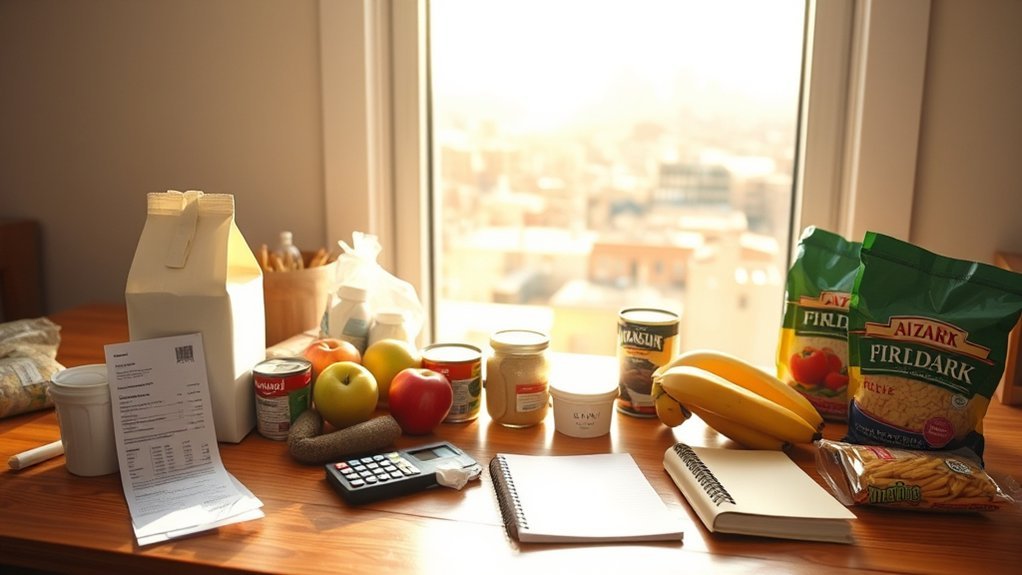If you’re planning life in Newark, you’ll want clear, practical numbers for rent, utilities, food, transport, and taxes so you can budget realistically. Typical one‑bed rents hover around $1,400, utilities and telecom add a few hundred, and groceries run above the national average — together they push most single adults into the mid‑$2,000s monthly. Keep going to see neighborhood splits, buying vs renting tradeoffs, and where you can trim costs.
Housing Costs: Buying vs. Renting in Newark

Because housing drives most household expenses in Newark, you should weigh buying and renting by comparing real monthly costs, not just sticker prices.
You’ll see average monthly rent around $1,744 (neighborhoods vary roughly $994–$2,126), so renting can keep monthly outlays predictable.
By contrast, median home price estimates range from about $559,000 to $667,569; with prevailing mortgage rates near 6.70% your mortgage payments on those prices often exceed typical rent—examples project roughly $3,500/month for a $400K mortgage and more at current medians.
Ownership adds property taxes (≈2.26% annually), utilities, maintenance, and higher upfront closing costs, which push effective housing costs well above rent in many cases.
Given housing consumes roughly 37–38% of spending and Newark’s cost index is ~123.8, run a rent vs buy cash-flow comparison that includes mortgage payments, taxes, insurance, and maintenance before deciding. Additionally, building a house can often be more expensive than buying an existing home, so it’s essential to consider all options.
Monthly Rent Breakdown by Neighborhood and Apartment Size

Having compared the real monthly costs of buying versus renting, next look at how rent itself varies across Newark by neighborhood and unit size so you can budget more precisely. You’ll use the median rent and recent listing data to set realistic expectations: monthly rent in Newark centers around $1,526, with higher-rent neighborhoods averaging about $2,126 and lower-rent areas roughly $994–$1,424. Recent averages put a one-bedroom apartment near $1,432 and a two-bedroom apartment around $1,839, though luxury pockets report both unit types exceeding $2,500.
| Neighborhood Tier | Typical Rent Range |
|---|---|
| High-rent | $2,000–$2,688 |
| Median | ~$1,526 |
| One-bedroom avg | ~$1,432 |
| Two-bedroom avg | ~$1,839 |
| Lower-rent | $994–$1,424 |
Account for utilities per month and telecoms when forecasting total housing cost; expect to add roughly $200–$400 beyond rent depending on usage and neighborhood rent differences.
Utilities and Monthly Household Bills

While rent gets the most attention, your monthly utilities and telecom bills will add materially to housing costs—plan on an extra $170–$400+ per month depending on what’s included and your usage.
In Newark, the average monthly utilities package (energy, water, trash, phone/internet) ranges widely: basic averages sit around $170–$220, while fuller estimates reach $657 if high-end telecom or separate heating fuels are included.
Expect energy bill volatility—regional energy CPI rose about 8.2% year‑over‑year—so budget conservatively.
- Energy bill: commonly $199–$220/month; seasonal spikes increase costs.
- Phone/internet: typical plans run $50–$189/month; bundle options may save money.
- Water/trash/sewer: often modest but vary by building; check lease coverage.
- Renters vs homeowners: both pay utilities; confirm what’s included in rent to avoid surprises.
Track monthly statements, compare providers, and set aside an extra buffer for Newark’s rising utility costs. Additionally, regular inspections and preventive measures for your air conditioning system can help avoid unexpected repair bills that may strain your budget.
Grocery Prices and Typical Food Budget

Expect to budget a bit more for food in Newark than elsewhere — groceries run about 5% above the national average, so plan accordingly. You’ll see typical grocery prices like bread $3.93–$4.06, milk $4.80–$5.02 per gallon, and a dozen eggs $3.68–$3.93. Proteins and produce vary: steak $8.49–$15.51/lb, ground beef about $6.96, potatoes (5 lb) $4.77–$7.20, bananas $0.70–$3.52.
Everyday items include coffee $5.36/lb, cooking oil $9.01, and beer around $8.00 a bottle.
Use MIT estimates to set expectations: roughly $4,957 annually for one adult and $14,569 for a family of four in Newark. That translates into a monthly food and groceries outlay that’ll affect your overall budget alongside Average Rent and other bills — food accounts for about 12.8% of household spending. Additionally, repair costs for school computers can also impact educational budgets, emphasizing the need for schools to manage expenses effectively.
If you want to trim costs, mix store brands, shop sales, and buy seasonal produce to keep per month grocery spending manageable.
Healthcare, Insurance, and Medical Expenses

When planning healthcare in Newark, you should budget for typical visit costs—expect doctor visits around $116–$184, dentist appointments $100–$132, and optometrist checks about $109–$111. Annual medical spending for a single adult averages about $3,337 and about $9,325 for two adults with two children, while out‑of‑pocket prescription costs average near $428 per year. Compare those figures to your insurance premiums and plan deductibles to see how much you’ll actually pay versus what’s covered. Additionally, it’s wise to consider average hourly rates for any potential legal advice related to healthcare decisions, as these can impact your overall budget.
Typical Visit Costs
Plan for slightly higher routine medical bills in Newark: a typical primary care visit runs about $172–$184, dental checkups average roughly $100–$132, and an optometrist exam is around $109–$111.
You’ll see doctor visit charges slightly above national norms, so factor medical expenses into monthly budgets. Annual out‑of‑pocket for a single adult is about $3,337, and healthcare costs take roughly 6.2% of household spending here.
- Expect routine care visits: $172–$184 per primary care visit.
- Budget dental visits at $100–$132 each.
- Plan optometry exams near $109–$111.
- Account for prescription costs and OTC items (e.g., ibuprofen ≈ $11.28) when estimating annual out‑of‑pocket.
Insurance and Premiums
Although overall healthcare costs in Newark run below the national average, you’ll still need to budget for premiums and out‑of‑pocket costs that can add up quickly.
Expect employer or private insurance premiums to help keep healthcare about 7% lower than the U.S. average, but household spending still averages 6.2% of income.
Routine out‑of‑pocket costs typically run doctor ~$116–$184, dentist ~$100–$132, optometrist ~$109–$111; specialist and prescription costs are higher.
For families, sample budgets show health-care around $1,326/month for a family of four, so include that when planning monthly expenses.
Don’t forget other insurance premiums: car insurance averages roughly $57/month, and Newark’s ~2.26% property tax can raise homeowners’ insurance and tax-related costs.
Transportation Costs: Gas, Transit, and Commuting

You’ll want to track local gasoline trends—recent regional estimates put prices around $3.39–$3.79 per gallon while statewide averages vary roughly $2.91–$3.46 depending on the source and month.
Compare driving costs (typical monthly insurance about $57 plus occasional maintenance like a $73 tire balance) against transit fares—PATH is $2.75 per ride and Newark–NYC NJ Transit options range from about $11 per trip to $200 for monthly passes.
With transportation spending in Newark lower than the U.S. average (≈12.4% vs. 16.6%) but regional CPI showing a ~4.9% year‑over‑year rise, you should weigh gas volatility against strong transit access when planning commuting costs. Additionally, exhaust leak repairs can impact overall vehicle maintenance costs, so it’s wise to keep an eye on your exhaust system.
Gasoline Price Trends
Frequently, gasoline prices around Newark sit between about $3.39 and $3.79 per gallon, a band that generally tracks recent New Jersey averages and stays slightly below some national peaks. You should monitor gas prices and gasoline per gallon trends because fuel costs form a predictable slice of your transportation expenses. You can offset volatility with public transportation and budgeting.
- Track weekly local gas prices to forecast monthly fuel costs.
- Compare cost per mile against NJ Transit pass pricing when planning trips.
- Factor routine auto costs (tire balance ≈ $73.33, insurance ≈ $57/month) into total transport expenses.
- Use PATH ($2.75) and local buses ($1.60–$1.80) where practical to reduce overall fuel costs.
Commuting & Transit Options
When you weigh commuting options in Newark, choose between driving and transit by comparing actual monthly costs: local gas usually runs $3.39–$3.79/gal (so budget roughly $100–$200/month for local driving), while a PATH trip is $2.75 and NJ Transit one-way to NYC is about $15–$15.75 with monthly rail passes near $200.
For commuting, factor in Transportation Options: PAY-per-ride PATH trips are economical for cross-Hudson access, while NJ Transit rail suits longer commutes. Driving adds parking and tolls plus average car insurance (~$57/month) and can exceed transit costs if you pay for Manhattan parking or bridge tolls. With over 100,000 daily inbound commuters, choose the mix—bus, light rail, PATH, or car—that minimizes your time and monthly cost.
Everyday Goods, Services, and Entertainment Prices

Typically, everyday goods and services in Newark run slightly above national averages, so you can expect routine expenses to add up: movie tickets cost about $14–$16.52. You’ll factor these into your monthly budget alongside rent and other essentials.
Grocery staples—bread $3.93–$4.06, milk $4.80–$5.02, eggs $3.68–$3.93—are predictable line items, and dining out averages help you plan discretionary spend.
- Entertainment: movie $14–$16.52; yoga class ~$26.01 per session.
- Dining & quick meals: McDonald’s ~$10.25; mid-range entrees $30–$50.
- Personal care: men’s haircut $22.22; beauty salon $33.61; dry cleaning $11.33.
- Household goods & meds: ibuprofen ~$11.28; men’s shirt $30.60; newspaper $13.86.
Additionally, you might consider cost-effective solutions like investing in a portable jump starter for emergencies, which can save you on towing and roadside assistance.
Use these figures to model weekly and monthly projections for Cost of Living comparisons. They show how goods and services in Newark will influence your rent-to-discretionary spending balance and overall monthly budget.
Income, Wages, and Typical Household Earnings

Although Newark’s cost of living pressures are clear, your household earnings often lag: the city’s median household income is roughly $46,460—well below New Jersey’s $97,126 average—while average individual salaries are reported near $78,997–$82,000 annually (about $6,583–$6,833 per month). You’ll compare those figures against living-wage estimates and typical job pay to shape a realistic monthly budget. Additionally, it’s crucial to understand the impact of average legal fees on your financial planning if you require assistance with immigration matters.
| Metric | Typical Value | Note |
|---|---|---|
| Median household income | $46,460 | Below state average |
| Average salary (individual) | $78,997–$82,000 | $6,583–$6,833/mo |
| Minimum wage monthly (FT) | ~$2,623 | NJ $15.13/hr |
Living-wage estimates for a family of four sit near $114,519–$117,799, far above local median income. Pay varies: management roles average ~$170,260, food service ~$37,500. When you set rent prices and monthly budget priorities, factor in where your earnings fall relative to these benchmarks and the gap to living-wage estimates.
Taxes, Property Rates, and Financial Planning

After comparing your earnings to local living‑wage benchmarks, you’ll want to account for how taxes and property rates reshape what you can actually afford.
Newark’s property tax rate (~2.26%) adds materially to annual housing costs when you multiply it against the average home price (median ~$528K–$667K).
Pair that with mortgage interest (recent ~6.7%) to model your monthly housing payment and escrowed tax obligations.
- Calculate annual property tax: average home price × 2.26% to estimate the tax line in your budget.
- Model take‑home pay after state income tax: NJ’s progressive state income tax (1.4%–10.75%) changes your net available for rent or mortgage.
- Add consumption costs: Newark’s sales tax rate is 6.625% (most clothing and groceries exempt) for discretionary spending.
- Compare to living wage benchmarks (~$117,799/yr for a family of four) to see gaps and guide saving, debt payoff, or housing adjustments.
Additionally, it’s crucial to consider legal expenses such as those incurred from hiring professionals, which can significantly impact your overall budget.
Frequently Asked Questions
How Much Do I Need to Make to Live in Newark, NJ?
You’ll need about $47,800/year as a single adult to cover basics, though targeting $72,000/year keeps average rent under 30% of income; for a family of four, plan around $117,800/year for local costs.
How Much Does It Cost to Live in NJ per Month?
You’ll likely need about $3,000–$3,500 monthly; Newark’s cost runs roughly 21–24% above the U.S. average. Expect rent ~ $1,744, utilities ~$200, groceries higher, and transit costs adding roughly $200 monthly.
How Much Money Is Needed to Live Comfortably in New Jersey?
You’ll need roughly $47,000–$83,000 annually for a single adult to live comfortably in New Jersey, with families requiring much more (around $117,800 for a family of four), depending on housing and lifestyle.
Is Newark, NJ Affordable?
Not really — Newark’s overall costs run about 23.8% above the U.S. average, driven by housing and energy. You’ll find it cheaper than NYC, but affordability depends on your income, rent choice, and utility expenses.
Conclusion
You’ll likely pay about $1,744 monthly for housing in Newark on average, so plan a total monthly budget in the mid‑$2,000s once utilities, groceries and transport are added. That 1,744 figure — with one‑bedrooms near $1,432 and two‑bedrooms about $1,839 — highlights how choice of unit shifts your costs quickly. Use these numbers to compare neighborhoods, weigh buying vs. renting, and build a realistic, data‑driven budget that fits your income.


